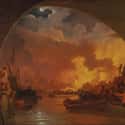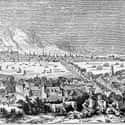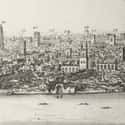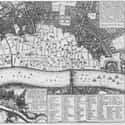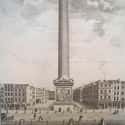-
(#9) The Government Instituted New Building Regulations Over Width Of Streets And Height Of Secular Buildings
The London Building Act of 1667 shaped London's look for centuries. The act banned the timber facades and thatched roofs that had fueled the blaze. It also regulated the width of streets and ordered some streets straightened to make it easier to protect the city from fire. Londoners could no longer build timber structures six stories high, nor could upper stories jut out over the ground floor.
The Act represented the first time England allocated money for surveyors, who helped enforce the regulations. These men became the first building control officers in history.
-
(#4) Londoners Blamed And Persecuted Local Catholics, Believing The Fire To Be A Nefarious Plot
After the Great Fire, a government committee investigated the outbreak. Londoners showed up with testimony that pointed the finger at Catholics. William Tisdale reportedly overheard an "Irish Papist" warn that there would be a "sad Desolation" in London in September 1666. Mr. Light from Ratcliff testified that months before the fire, a Catholic said, "You expect great things in Sixty Six, and think that Rome will be destroyed, but what if it be London?"
Suspicion against Catholics persisted. In 1681, a plaque commemorating the fire read “Here by the permission of Heaven, Hell broke loose upon this Protestant city from the malicious hearts of barbarous Papists."
-
(#2) 65,000 Homeless People Dispersed To Villages Around The Area, While Rent In London Skyrocketed
The fire completely burned 80% of the area within London's medieval walls, leaving behind only a few stone ruins and left at least 65,000 people homeless. In the early days after the fire, when the ground in many places was still too hot to walk on, displaced Londoners camped in fields outside the walls. Soon, many traveled to villages outside of the capital or other parts of the city.
The housing shortage caused rent prices in London to rise exponentially. Within only days, leasing costs rose about 200%, but within two weeks, houses grew 10 times more expensive. Rental and leasing prices remained high through 1668, but even though the city was expensive, many merchants and tradesmen were willing to pay these extraordinary prices.
-
(#12) Medieval London Was Rebuilt In Brick And Stone
Within four years of the fire, Londoners had rebuilt 6,000 houses. But they looked different from the pre-fire homes. Medieval London was built from wood and thatch, but after the Great Fire, Under the Rebuilding Act, Londoners were required to build new homes from brick and stone. The Act declared, "No man whatsoever shall presume to erect any house or building, whether great or small, but of brick or stone." Furthermore, rather than pitch roofs, which helped spread the fire, new roofs were required to be made from tiles.
The new homes were also larger than their predecessors. Even though the city limited the height of new buildings to four stories, rich merchants snatched up large plots to build grand homes.
-
(#13) Londoners Vowed To Never Forget The Fire By Erecting A Huge Monument
In 1671, London began to erect the Monument to the Great Fire of London. Designed by Christopher Wren, the monument stands close to where the fire broke out.
But the monument did more than memorialize the fire: It also represented London's triumph over the fire. On the south panel, it reads, “Haste is seen everywhere, London rises again, whether with greater speed or greater magnificence is doubtful, three short years complete that which was considered the work of an age.”
-
(#8) Physician Nicholas Barbon Set Up The First Insurance Company To Capitalize On The Fire
The Great Fire created business opportunities for Londoners, including Physician Nicholas Barbon who capitalized by creating the first insurance company. After so much property loss and disputes over who would pay, Barbon saw he could insure people's homes from future fires and make a profit. Like modern insurance companies, Barbon's company, Fire Office, promised to pay back damages from future fires for those who paid for an insurance policy. He used the Great Fire as advertisement by asserting that if those who lost their homes in the fire had an insurance policy their losses would have been compensated.
Unlike modern insurance companies, however, Fire Office handed out fire marks to policyholders. If a fire broke out, the company sent out private fire brigades to protect homes that displayed the fire mark. If they didn't see the correct fire mark, the brigades left the building to burn.
In the aftermath of the fire, Barbon also bought up land and became one of the city's most prominent builders.
New Random Displays Display All By Ranking
About This Tool
The Great Fire of London occurred from September 2nd to 5th, 1666. It was the worst fire in British history. It burned down many buildings, including St. Paul’s Cathedral, but this fire also cut off London since 1665. The plague problem. The cause of the fire was a fire in a bakery in Pudding Lane. A gust of wind quickly blew the flames across several narrow streets full of wooden houses, and the fire spread across the city.
The fire lasted for 4 days, including 87 churches, 44 companies, and 13,000 houses burned down. About one-sixth of the buildings in London, the largest city in Europe, was burned down. The random tool tells what happened in London after the fire.
Our data comes from Ranker, If you want to participate in the ranking of items displayed on this page, please click here.











